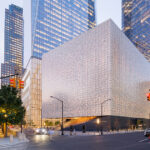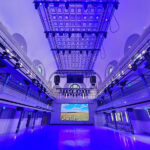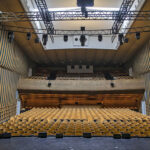 As Las Vegas continues to boom, it seems as if there is constantly a new hotel vying for our evenings (and our checkbooks): Cirque du Soleil shows now outnumber the seats at a blackjack table, Celine Dion performs in her own Coliseum, Elton John fills in when she’s weekending in the Hamptons and Franco Dragone produces everything but burlesque shows.
As Las Vegas continues to boom, it seems as if there is constantly a new hotel vying for our evenings (and our checkbooks): Cirque du Soleil shows now outnumber the seats at a blackjack table, Celine Dion performs in her own Coliseum, Elton John fills in when she’s weekending in the Hamptons and Franco Dragone produces everything but burlesque shows.
To compete in this field, venues on the strip are going after big-name performers that can pull in viewers from every generation, including one of the most well-known crooners of modern day, Barry Manilow.
Say Goodbye
“We were out finishing our last, final, goodbye, farewell, never-working-again tour, and then the offer for the Hilton came up.”
 Seth Jackson has been Manilow’s lighting director since 1998, taking on additional duties regularly since then. For Manilow: Music & Passion, Jackson has taken on the role of show director, working with Manilow to craft the show.
Seth Jackson has been Manilow’s lighting director since 1998, taking on additional duties regularly since then. For Manilow: Music & Passion, Jackson has taken on the role of show director, working with Manilow to craft the show.
“On the last weekend of the tour, in Nov. 2004, we had our first meeting about what a Vegas show would look like, and we opened in Feb. 2005. So it was a ridiculously fast time to develop a full production show like that for Vegas,” he says.
Lighting and video elements were developed by Jackson while set pieces were designed by Jim Lenahan. In order to meet the tight deadline, delivery of set pieces, lighting equipment and video content was distributed across multiple industry heavyweights. Set construction was handled by All Access, Flix F/X and PRG. PRG also provided lighting equipment alongside Technical Productions. Custom video content for the show includes clips from Visionering, Mode Studios and JLPD.
Can’t Drive Without You
“Barry’s initial feeling about the entire thing was that he wanted the big Vegas look. It needed to have the big spectacle that Vegas audiences are used to. But it also had to represent him,” Jackson says.
“While we were putting the show in, the Hilton was renovating their theatre. So they gutted all of that and they rebuilt the fly system for us.
 “One of the things that Jim Lenahan immediately gravitated to was, ‘Look, there are 87 line sets.’ That’s something people aren’t used to seeing anymore, a big drop-and- fly-stuff show. These line sets are moving constantly. Our flymen work their tails off.”
“One of the things that Jim Lenahan immediately gravitated to was, ‘Look, there are 87 line sets.’ That’s something people aren’t used to seeing anymore, a big drop-and- fly-stuff show. These line sets are moving constantly. Our flymen work their tails off.”
Jackson and his team ran with these sentiments, taking advantage of the opportunities not available to a touring production.
At the heart of the design are two multitier band risers that include platforms for no less than nine musicians, seven keyboards, one drum kit, countless guitars and a host of percussion equipment.
Throughout the show, the stage is constantly reconfigured, with each band riser able to glide and rotate to any position required by the creative team. Below each of these modern day bandstands hides a rather ingenious—and somewhat lowtech— method of movement.
Jackson says, “All Access came up with this idea…Basically, our band risers are in two halves, and they’re driven by golf carts [laughs], but what amounts to a forklift, really. And these two guys sit under these risers all night long, and they can’t see anything. They get their cues from stage management. ‘Drive to this position.’ And they literally follow tape lines on the floor. They have no idea where they’re going. As long as they just follow their white marks. And somehow, they’ve managed not to run into each other. It’s fairly impressive.”
Commenting on the unusual approach to stage automation, Jackson said, “There was just no other way to do it because the carts are so large we couldn’t do tracks. They had to turn and manipulate…it was several days of rehearsals just for the guys to learn how to drive the things.”
 The staging innovations are seen throughout the show, and include a Plexiglas bridge developed by Stage Rigging.
The staging innovations are seen throughout the show, and include a Plexiglas bridge developed by Stage Rigging.
“It kind of unfolds and rolls down from the ceiling, so that Barry can go out in the crowd during ‘Copa’. That’s always a big fun thing,” Jackson says.
Could It Be Magic? No, It’s Don
Jackson’s concept for the show’s lighting came about from his discussions with Manilow and in part from the equipment left behind by a former resident.
“Years ago, Starlight Express had been the show that had been in that room. There was this enormous hunk of Starlight left over, that they had used for years for road shows that came through,” Jackson says.
“Moving light-wise, the Hilton was also upgrading at that time. So their head electrician, Michael Rankin, specified most of the gear for the Hilton to purchase. They gave me that list, and then I augmented based on that. The majority of the system is High End Systems x.Spots, Studio Spots, a ton of ACLs, PARs, scrollers and all of the stuff that had been left over from Starlight that we put to use.
“None of our moving lights are wash lights. We did all hard-edge fixtures because we had an abundance of wash stuff available to us through the conventional equipment.”
Don Toto is the head of the electrics department at the Hilton. As the show enters its second full season, the rig continues to grow, with the help of Toto, and much to the surprise of the LD.
Jackson says, “Don has, over the course of months, added more and more back in. We’ll go away for a break and we’ll come back, and he will have put in another 20 ACL bars here, there and everywhere. He’ll put them on handles for me during the show and I’ll just sort of throw them in at different times, and we’ll make notes and add them into the cues. It’s unbelievable.
“It has this big, grand, ‘80s rock show look to it now because there are tons of ACL beams and PARs with scrollers.”
 Moments to Remember
Moments to Remember
“And then in the midst of all that, you’ve got all this technology. We’re running five High End Systems Catalysts, a Flying Pig Systems Wholehog Hog 3 and six HES DL1s. So there’s all this high-tech stuff mixed in with this great old-school look.”
While Jackson has a variety of output devices to send content to, the biggest and most eye-catching is also the largest set piece in the theatre. In the shape of a stylized letter “M,” the proscenium arch frames the stage while offering Jackson a couple of ways to compliment (or contrast) the look on stage.
“The “M” is lit with 50 or 60 Color Kinetics Color Blast LED units behind Plexiglas that outline the shape,” Jackson says.
It’s also got three circuits of rope light running through it, just for good measure.
| Gear 40 ETC 10º Source Four Lekos 300 PAR 64s 30 PAR 64s with Wybron Scrollers 80 4-Lamp ACL bars 10 ETC Revolutions 19 High End Systems x. Spot Extremes 24 High End Systems Studio SpotCMY 8 Martin MAC 550s 8 Martin MAC 500s 4 Martin MAC 2000s 6 High End Systems DL1s 2 18K DLP Projectors 5 High End Systems Catalyst Media servers 1 Flying Pig Systems Wholehog 3 Console 1 ETC Obsession Console Crew Lighting Design and Show Direction: Seth Jackson Set Design: Jim Lenahan Set Construction: All Access, Flix F/X, PRG Lighting Equipment: PRG and TechnicalProductions, Inc Video Equipment: CWP, Marty Wickman Video Content: Visionering, Mode Studios, JLPD Console Operators: Don Toto Stage Manager: Amber Martin Production Manager: Sacha Bambadji |
“So again, here we’ve got ACLs, but we also have LED Color Blasts. Go figure. Then we’re using these large 18K DLP front projectors, with masks in the Catalyst, so we can actually do video stuff on only the proscenium for various looks and songs. It keeps it hoppin’.”
Along with feeding typical types of content from the Catalyst servers, Jackson has also integrated the band with the process, allowing the sequence operator onstage to fire video clips directly from the Digital Performer software that plays back loops and underlying music for each number.
“The drummer starts and stops it with the hit of a space bar. They’re not even really aware of it, but it’s talking to another computer that’s receiving that trigger. Then that sends it up to the Catalyst, and the Catalyst can feed it out with whatever proper masking and arrangement,” Jackson says.
Even with all of this at their fingertips, the team took Manilow’s “Big Vegas” vision to heart, and just when you think things can’t get any bigger…well, I bet you know where this is going.
“In a big moment in the show, we actually fly the proscenium out as one of the large production things. And it just opens up the whole gigantic amount of stage that the Hilton stage really is. I think it’s 70 or 80 feet across,” Jackson says.
“It lifts up off the ground and just opens up the whole stage as we get in to the bigger production elements of the end of the show. Just to enhance the width and give us the full breadth and width and height of what we’ve got there on the stage.”
I Light the Songs
Manilow regularly adds material to the show, changing set lists night-to-night, and sometimes mid-show.
“He could arrive on a Wednesday with two or three new songs that he wants to put in the show that week. He’ll rehearse them on Wednesday, and then we’ll do Thursday afternoon and tech them out. Then Thursday evening, he’ll come in for sound check. We’ll run them with production to make sure it’s all good. Then Friday night, boom, they’re in the show.”
Jackson says that while some would consider the arrangement torturous, both the band and the crew enjoy a process where everyone’s opinion is not only accepted, but requested.
“He likes to send the band away early for a couple of afternoons so that he can sit out front with a tape and look at everything that we’ve programmed. In some sense, it’s to make sure that it’s what he wants. But in another sense, it’s like, ‘Oh, so this would really be better if I make sure to finish this song dead center so that you can do that lighting thing,’”Jackson says. “He’s very collaborative with everybody. He and his band…it’s a complete democracy. People are free to try stuff. He’s a rehearsing fool. He loves to rehearse. It gives him a much better show. Everybody’s on the same page. That makes it work for the production of the show.”
Looks Like We Made It
So, with a lot of music and a hefty dose of passion, Jackson and his team have brought a legendary artist to the stage for one “last, final, goodbye, farewell, neverworking- again” show.
“And it continues to evolve. Barry’s talking about changing the show and adding things,” Jackson says.
Based in St. Louis, Jackson can be still be found at almost every performance, and he can tell you the name of almost any flight attendant on the routes between there and Sin City.
“What it amounts to is that Barry works about 25 weeks a year, and they come in three- to four-week blocks. Because the show changes so much, it’s become kind of commonplace that I’ll just be out there to adjust some changes or for new material that’s coming in.”
Well, I don’t know if I’d call it torture, but those are most certainly some big frequent flyer miles.
Phil Gilbert is a freelance lighting designer/ programmer. He can be reached at pgilbert@ plsn.com.


